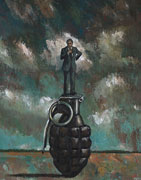Wharton finance professor Luke Taylor has heard the conventional wisdom many times: Boards of directors often fail to do their jobs when it comes to firing underperforming CEOs. “When I talk to my friends outside of finance and read the popular press, you find a knee-jerk reaction that not enough CEOs are fired,” says Taylor. The data shows that “2% of Fortune 500 CEOs on average are fired every year, but we have no benchmark for judging whether [that figure] is a lot or not enough.”
Taylor set out address that question. His goal: To model the decision to fire a CEO and quantify the forces at work. His work was published in the December 2010 issue of The Journal of Finance in a paper titled, “Why are CEOs Rarely Fired? Evidence from Structural Estimation.” Taylor’s model contained two costs of firing a CEO. Direct costs, such as severance, make up the first component. The second component is what Taylor terms “entrenchment” costs, which are intangible costs that board members feel but shareholders do not — for instance a personal relationship between board members and the CEO. If there are any entrenchment costs, then boards fail to get rid of CEOs whom shareholders would like to see fired — in short, creating an environment where fewer top executives are let go than should be, based on performance.Taylor’s model found that the entrenchment cost per firing was, on average, $1 billion — far more than the $300 million in direct costs.
One area Taylor did not examine is what impact a higher level of CEO turnover would have on the ranks of CEOs. His model does, however, predict that if the entrenchment cost went to zero — meaning that sacking a CEO came with only financial costs and no intangible consequences — the annual rate of CEO firings for the S&P 500 would go from 2% to 13%. That would result in a one-time bump in value for the S&P 500 of 3%. Taylor notes that this higher level of firings could potentially cause talented individuals to choose career paths other than those that might lead to a CEO position.
“I think fewer people would want the job,” he says. “When a CEO is fired, research shows there is a huge impact on that person’s career.” For instance, Taylor points to previous studies showing that when dismissed CEOs go on to manage another firm, that firm is 90% smaller and the CEO is paid significantly less. If boards are too quick to push leaders out, Taylor suggests, new CEOs may be less inclined to take risks, a shift that could dampen corporate performance over the long term.
Taylor’s work involved two separate pieces. First, he created a model for a board’s decision to fire a CEO. The complex framework — which was four years in the making — includes factors like the company’s profitability versus its industry’s, the CEO’s ability, and the costs involved in replacing him or her. All the elements of this model can be estimated, including the real costs to the company of replacing the CEO, which includeseverance or retirement packages, fees to executive search firms, disruption costs and any other CEO turnover costs that affect profits.
As for nailing down the more intangible entrenchment costs, Taylor turned to the hard data on CEO firings. Because no available database on the topic exists, the first step was to look at all CEO departures between 1970 and 2006 based on the Forbes annual list of CEO compensation. To determine if a CEO was fired versus left on his or her own accord, Taylor had to do a bit of tea leaf reading. He pulled Wall Street Journal stories on the CEO exit and applied a few rules. Obviously, if the board characterized the departure as a firing, it was classified as such. For less clear-cut cases, Taylor used set criteria to determine if an exit was voluntary or not. For example, if the CEO was labeled as “forced out” or if the exit didn’t involve death, health issues or the acceptance of another position elsewhere, it was assumed that the individual had been fired.
Once Taylor had that data, he plugged it into his model. Based on the history of about 2% of Fortune 500 CEOs who are terminated annually, Taylor was able to figure out what cost the board was placing on firing the boss. “Boards were behaving as if firing the CEO costs the company about $1.3 billion,” Taylor says. But his work showed that the hard costs to the company were just $300 million. That includes not only the severance and headhunter costs, but the impact on the firm’s bottom line from all the upheaval. For example, much of the upper level management team may also be replaced when a new CEO comes in. And it may take time for that new team to build relationships inside and outside the company, and set a new strategy.
Still, that leaves a whopping $1 billion in costs that are unaccounted for. According to Taylor, this remaining $1 billion probably stems from two factors. First, there is a personal cost to board members who terminate the company leader — in the form of the time and stress of making a management change — as well as the loss that directors face in the departure of a business ally or golfing friend. Another contributor may be the fact that the board simply does not care all that much about maximizing shareholder value — at least not as much as keeping a CEO with whom they feel comfortable. Taylor notes that while his model did not attempt to further analyze those two factors to see which was the dominant force, both can contribute to reluctance to remove an underperforming CEO. In any case, evidence from his model is clear, he says: “CEO entrenchment is real and it’s big.”
Ammunition for Boards?
The story varies a bit when studying different time frames or company sizes. When Taylor looked at the larger half of the S&P 500, he found the entrenchment cost was close to zero — in fact, it was slightly negative. Why the difference between small and large firms? One possibility, Taylor says, is that directors in larger firms have a higher public profile and care more about their public reputations. That may make them more inclined to fire a CEO when times are tough.
Taylor’s work also found there was less entrenchment in the 1990 to 2006 timeframe than in the earlier period studied. He says that this is not surprising, in part because of growing shareholder activism over the last two decades. Regardless, Taylor says it is clear that “entrenchment has gone down, and that is good news.”
One seemingly counterintuitive finding in Taylor’s work is that a company’s profitability is not a good predictor of whether a CEO gets fired or not. Taylor says that this is often a point of outrage in the popular press where the question is asked, “How can a CEO of a money-losing company keep his job?” According to Taylor, the reason profits are not a good predictor of CEO firings is that the board of directors looks at a number of other factors when it evaluates a CEO, a circumstance he collectively calls the “additional signal.” This includes everything from how the CEO is spending his or her time, to changes in market share for the company, to new projects in the works that may not yet be contributing to earnings. Paying more attention to these factors makes complete sense, he adds, because “there is a lot of noise in profit [numbers],” including accounting charges and other forces outside the CEO’s control.
In fact, eliminating the $1 billion entrenchment cost does little to move the needle on the profitability of the S&P 500 companies, according to Taylor. His model shows that eliminating this cost altogether results in an increase in profitability across the S&P 500 of only 0.5% — for two reasons. First, even with more aggressive boards, bad CEOs can still do some damage before they are fired. Second, if boards force out CEOs more frequently, the direct costs associated with changing leaders — severance and the like — will have to be absorbed more often. Taylor notes there would also be a likely diminishing return at work since the truly terrible leaders are already being fired. In this more activist era, the additional firings would come from “bad but not horrible CEOs.” This means that the bump upward to company performance from the change would likely be a bit muted.
“If CEO turnover entails a real cost for shareholders — for instance, because searching for a replacement is costly — then firing an unskilled CEO is not always in shareholders’ interests,” Taylor writes in his paper. “Complicating matters, the board cannot directly observe CEO ability, but instead learns about it over time…. At each point in time, the board … assesses the CEO’s ability, and then decides optimally whether to replace him or her with a new CEO of uncertain ability.”
Taylor says the results of his model should provide ammunition for some boards that are under pressure from irate shareholders and from populist anger over CEO pay. In particular, boards of larger firms — where the entrenchment cost has been shown to be close to zero — can argue they have been more aggressive than many others in dumping underperforming leaders. Members of such boards “could defend [themselves] against this rage by saying, ‘Here’s a paper that shows that our CEO firing rate is optimal for shareholders,'” says Taylor. “They could argue that the reason they don’t fire CEOs more often is that it takes time to learn about a CEO’s ability, and there are real costs to shareholders from the firing.”



